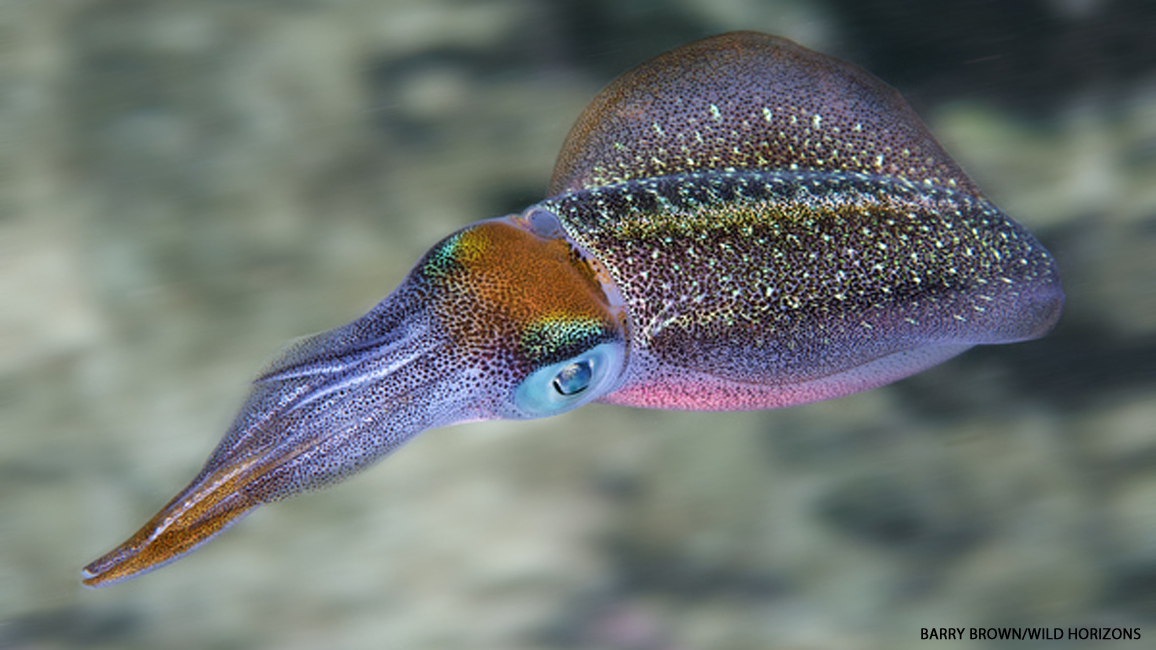
Squids
By Kathy KrankingDo squids make you squirm? If so, maybe you don’t know enough about these amazing animals!

Sure, squids are squishy and squiggly. But that’s no reason to be squeamish about them!
They’re also brainy animals that can move by jet power, make themselves disappear, and even “talk” to each other!
Keep reading for more scoop on squids!
Squid Facts
- The cockeyed squid has a big eye that faces up and a smaller eye that faces down!
- The bobtail squid comes out to hunt at night. During the day, it stays partly buried in the sand.
- Two bigfin reef squids ripple their fins as they swim along.
- The piglet squid has a rounded body like that of a small pig! This squid is mostly see-through and often swims upside down.
- This cute little stubby squid is more closely related to octopuses than other squids are.
- Like other squids, this beautiful reef squid can change the colors of its skin.
- When threatened, this Humboldt squid shoots “ink” out of its siphon. The Humboldt squid grows as big as an adult person.
- Some kinds of squids have “teeth” around the rims of their suckers—the better to grip with!
- In the center of a squid’s arms is a sharp beak.
- You can faintly see the stripes on the baby striped pajama squid inside its egg (second photo down).
- About two-thirds of squid species, including these bigfin reef squids, have parts that glow in the dark.
- About the size of a grain of rice now, this colorful, two-day-old common squid will grow to be longer than your arm.

Squid Stuff
So what exactly is a squid, besides squishy?
Squids belong to a group of animals called cephalopods (SEF-uh-luhpods)—intelligent animals with soft bodies; excellent eyesight; and long, sucker-covered arms.
Octopuses and cuttlefish are in this group and are close cousins to squids.
More than 300 species of squids live in oceans around the world, from shallow coral reefs to the darkest depths.
They range in size from the thumbnail-sized pygmy squid to the giant squid, which may be longer than a school bus!
On the Hunt
Probably the first things you notice when you see a squid are its wiggly arms.
A squid has eight arms, as well as two longer tentacles (TEN-tuh-culs).
The arms are covered with suckers, while the tentacles have suckers only at the tips.
The long tentacles are what squids use to catch prey.
When a squid is hunting, its tentacles reach out to grab fish, crabs, shrimp, or even other squids.
Some kinds of squids have sharp hooks on their arms or suckers or both, making it easier to grab slippery prey.
Once a squid has grabbed its prey, it pulls it in toward its mouth, which is hidden in the center of its arms.
A squid’s mouth is actually a sharp beak that looks very much like a parrot’s!
Using its arms to hold the prey, the squid rips it into pieces.
Great Escapes
A squid has a pretty cool way of getting around: It squirts water out of a tube called a siphon (SYE-fun).
As the water squirts out, the squid jets off in the opposite direction.
When swimming at slower speeds, squids use their fins, as well.
A squid also uses its siphon to protect itself. If an enemy comes close, the squid shoots “ink” out of the siphon.
That can confuse the enemy long enough for the squid to jet away to safety.

The Skin They’re In
Squids have amazingly tricky skin. It can change color!
That comes in pretty handy when an enemy is near: By changing color to match its surroundings, a squid can make itself “disappear”!
Squids also use color changes to communicate with each other.
For example, they may send signals to attract mates or warn away rivals.
Color patterns can also make it harder to see a squid’s shape, keeping it safe from enemies.
Many kinds of squids have parts that glow in the dark.
Some kinds use chemicals in their bodies to make the light.
Others have a special kind of bacteria that glows. The glow can have different purposes. One may be to blend in with the light that comes from the surface. This makes it hard for enemies below the squid to see it.
Little Squids
After a male and female squid mate, the female lays eggs.
The eggs are often grouped inside an egg case.
Some kinds of squids lay thousands or even millions of eggs!
Most squids don’t stick around to care for their eggs or young. They usually die soon after laying eggs.
When the eggs hatch, tiny paralarvas (pair-uh-LAR-vuhs) come out. Even though each is smaller than a pencil eraser, they’re able to jet around on their own.
Off they go—squishy and wiggly and squiggly—into their new lives.
The Giant Squid
For hundreds of years, people have told stories of the giant squid. In the stories, the squid is a monster that grabs ships with its long arms and pulls them under.
The truth?
Well, since they grow to be longer than school buses, giant squids are gigantic. But they don’t attack ships or people.
They live deep in the sea, where they are hard to find.
Even so, there have been a few rare sightings of live giant squids, such as the one in the bottom right photo, attracted by a bait squid hanging off a boat.
The giant squid isn’t the only supersized squid jetting around in the ocean. There’s also the colossal squid, which weighs more but isn’t as long.
















